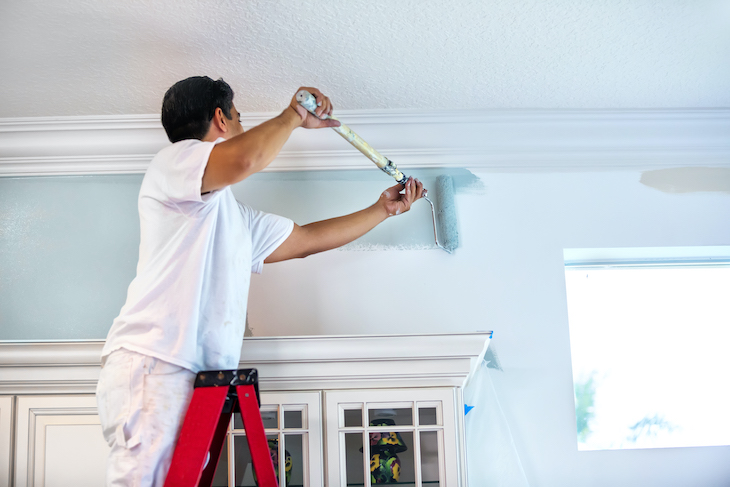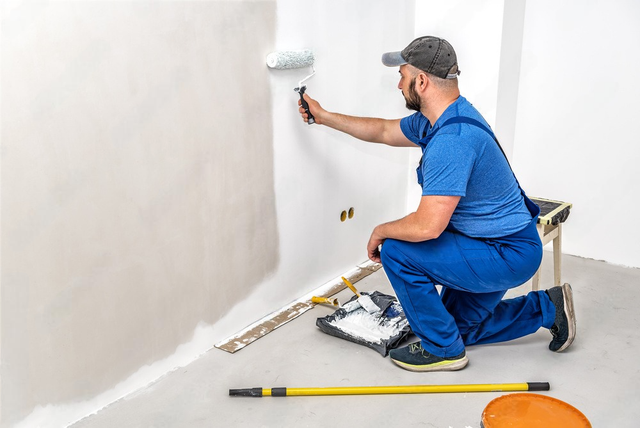The In-Depth Guide to Paint Finishes from paint shops in corpus christi
Discovering the Different Kinds Of Paint: An Overview for each Job
Discovering the various sorts of paint is vital for accomplishing the preferred end result in any type of task. From water-based options that offer benefit to oil-based paints recognized for their longevity, each selection has its merits. Specialized paints can include one-of-a-kind structures or finishes, while eco-friendly alternatives accommodate those seeking sustainability. Recognizing these distinctions can significantly affect the success of a paint endeavor. What factors should one take into consideration when making the best choice?
Understanding Paint Types: Water-Based vs. Oil-Based
Paint kinds can substantially impact a task's end result, and understanding the distinctions between water-based and oil-based paints is vital for notified decision-making. Water-based paints, frequently referred to as latex paints, are composed of water as the main solvent. They dry rapidly, release fewer unpredictable organic substances (VOCs), and are simple to tidy up with soap and water. This makes them a prominent choice for interior applications and environments where air top quality is an issue.
On the other hand, oil-based paints utilize organic solvents, giving a long lasting, shiny coating suitable for surface areas exposed to tear and put on, such as trim and cabinets. They take longer to dry, call for mineral spirits for cleaning, and have a more powerful odor. paint store corpus christi tx. Selecting between these two types depends upon the details needs of the task, considering factors such as wanted surface, application atmosphere, and convenience of upkeep. Each kind has distinctive advantages and constraints, leading the selection procedure
The Finish Matters: Selecting In Between Matte, Satin, and Gloss
When selecting a paint coating, the option in between matte and shiny choices substantially impacts both visual appeals and capability. Matte coatings provide a subtle, non-reflective look that can conceal surface blemishes, while glossy coatings give sturdiness and ease of cleansing. Recognizing the benefits and factors to consider of each can aid in making a notified choice for any painting project.
Matte End Up Advantages
Numerous house owners dispute the qualities of different surfaces, matte paint offers distinct advantages that make it a prominent option for both indoor and outside applications. Among the key advantages of matte coating is its capacity to hide surface blemishes, developing a smoother look on walls. This high quality is particularly beneficial in older homes or spaces with uneven surfaces. Furthermore, matte paint takes in light as opposed to reflecting it, which can enhance the aesthetic of an area by giving an extra advanced and muted look. Matte finishes are usually much easier to touch up than glossier choices, as they can mix a lot more perfectly when used over existing paint. Generally, matte paint is an excellent selection for those seeking a refined and sophisticated finish.
Shiny Finish Factors To Consider
A glossy surface can drastically alter the understanding of a space, using a reflective and smooth quality that improves both shade vibrancy and light within a room. This surface is often preferred for high-traffic locations and surfaces like bathroom and kitchens, where longevity and ease of cleansing are essential. Nevertheless, its reflective nature can highlight blemishes on wall surfaces, making proper surface area prep work crucial. Glossy paints also have a tendency to reveal finger prints and smudges a lot more conveniently, requiring routine upkeep. In addition, lighting plays a considerable function; in brilliant settings, a shiny coating might create glare, affecting the total visual. Consequently, cautious factor to consider of the certain application and setting is necessary when selecting a glossy finish for any project.
Specialized Paints: When to Utilize Textured or Chalk Paint
Specialty paints, such as distinctive and chalk paint, deal special visual and practical benefits that can improve various surfaces. Textured paint is suitable for creating depth and dimension on walls, hiding flaws while adding a three-dimensional feeling. It is especially helpful in high-traffic locations where longevity and visual interest are important.

Both kinds of specialized paints can change rooms, however choosing the right one depends on the preferred effect and surface area needs. Textured paint might match larger areas, while chalk paint can revitalize smaller sized products, showcasing creativity and individual style in any task.
Outside Paints: Safeguarding Your Surface Areas From the Aspects
Outdoor paints are crucial for securing surfaces versus various weather. Recognizing their weather condition resistance features, proper surface prep work requirements, and reliable application techniques can substantially enhance durability and performance. This area will detail key factors to consider for choose and utilizing exterior paints effectively.
Weather Condition Resistance Includes
Weather resistance is a crucial feature of outside paints, as it establishes how well surfaces can hold up against the harsh aspects of nature. High-grade outdoor paints are developed to withstand damages from UV rays, dampness, and temperature fluctuations. UV resistance assurances colors remain lively in time, stopping fading and staining. Moisture resistance protects versus mold and mildew, which can endanger the integrity of surfaces. Additionally, paints with outstanding temperature level resistance can increase and get without cracking, maintaining their safety qualities. When selecting exterior paints, it is vital to take into account these weather resistance features, as they add to the longevity and resilience of painted surfaces, making sure they continue to be cosmetically pleasing and useful regardless of direct exposure to see this site the aspects.
Surface Preparation Needs
Correct surface area preparation is a fundamental action in attaining the most effective outcomes with outside paints. To guarantee perfect adhesion and durability, surface areas need to be completely cleaned, getting rid of mold, dirt, and grease. This can be achieved using a stress washer or a scrub brush with an ideal cleaning solution. As soon as cleaned up, surface areas must be evaluated for any peeling or flaking paint, which have to be scuffed away to create a smooth structure. Repairing any type of cracks or openings is also essential, as these can enable moisture infiltration. In addition, sanding harsh areas advertises better paint bond. Using a primer fit for exterior use can boost the paint's performance, guaranteeing a long-lasting coating that endures the aspects. Correct preparation is essential to an effective exterior paint project.
Application Methods Tips
While using exterior paints, it is important to use efficient strategies that assure surface areas are well-protected against the elements. First, select the ideal day for paint; reduced moisture and light temperature levels enhance bond and drying out. Prepping the surface area extensively-- cleansing, fining sand, and priming-- makes sure far better paint bond and durability. Using top quality brushes or rollers can offer a smoother finish, while spray painting might cover huge locations effectively. Applying paint in thin, also layers stops runs and drips. It is recommended to follow producer instructions regarding drying out times in between coats. Verify correct air flow during application to facilitate drying out and reduce exposure to fumes. These strategies considerably enhance the longevity and effectiveness of outside paint.
Eco-Friendly Options: Low-VOC and Zero-VOC Paints
As consumers come to be progressively familiar with the ecological effect of their choices, zero-voc and low-voc paints have become prominent choices. These paints are formulated to contain less volatile natural compounds (VOCs), which are chemicals that can vaporize into the air and add to air pollution and health and wellness problems. Low-VOC paints normally contain a restricted here are the findings amount of VOCs, while zero-VOC paints have negligible degrees, making them safer for both outside and interior use.
The advantages of making use of low-VOC and zero-VOC paints expand past ecological considerations; they likewise enhance interior air high quality, lowering the risk of breathing concerns and allergic reactions. Several manufacturers now use a selection of colors and surfaces in green options, making it much easier for customers to locate ideal products for their projects. By selecting these paints, individuals can add to a much healthier setting while still attaining the aesthetic they desire in their spaces.
Tools and Techniques for a Perfect Application
Accomplishing a perfect paint application needs the right devices and methods, which can considerably boost the last outcome. Choosing the proper brush or roller is crucial; brushes function well for sides and detailed locations, while rollers cover bigger surfaces effectively. Using premium materials assures much better paint distribution and lessens streaks. For optimal results, surface prep work is essential. This consists of cleaning, sanding, and priming surface areas to advertise bond.
Technique also plays a substantial duty. The "W" technique with a roller helps to evenly disperse paint, while long, smooth strokes with a brush stop visible lines. Functioning in areas enables better control and mixing. Furthermore, applying slim coats is preferable to thick layers, lowering the danger of drips and uneven appearances. Lastly, keeping a damp edge throughout application helps attain smooth adjustments between locations. By combining these devices and methods, one can attain a refined and specialist surface.
Tips for Maintaining and Taking Care Of Your Painted Surfaces
Correct maintenance and treatment of painted surfaces can substantially prolong their life-span and preserve their look. Normal cleaning is necessary; using a soft fabric or sponge with light soap and water can remove dust and dust without harming the paint. It is recommended to prevent unpleasant cleaners or scrubbing pads, as these can scrape the surface area. In addition, using a fresh layer of paint every couple of years can revitalize the color and protect against wear.
For outdoor surface areas, checking for indications of peeling or fading routinely is very important. Promptly resolving any type of issues avoids additional damage. In locations susceptible to wetness, such as restrooms, making use of mold-resistant paint and making sure appropriate air flow can assist maintain the stability of the paint. Using protective surfaces can shield against UV rays and spots, guaranteeing that repainted surfaces stay vivid and appealing for years to come, eventually boosting the overall aesthetic of the room.

Regularly Asked Inquiries
Can I Mix Different Kind of Paint Together?
Mixing various kinds of paint is typically not recommended, as it can bring about concerns like bad adhesion, irregular structure, or unexpected chain reaction. It's ideal to utilize compatible paints for suitable results and toughness.

How Do I Correctly Store Extra Paint?
To correctly keep leftover paint, seal the container firmly, label it with the day and shade, and maintain it in a trendy, completely dry location away from direct sunlight and severe temperature levels for excellent conservation.
What Is the very best Method to Throw Away Extra Paint?
The very best way to deal with extra paint is to examine regional policies, as numerous areas have actually assigned contaminated materials facilities. Take into consideration donating useful paint to neighborhood companies or schools for their jobs.
How Can I Tell if Paint Is Still Excellent to Use?
To figure out if paint is still excellent, examine its uniformity, color, and scent. If it shows up separated, has an unpleasant smell, or reveals substantial changes in structure, it's most likely no much longer usable.
Are There Age Restrictions for Investing In Paint Products?
In many regions, there are no certain why not find out more age constraints for acquiring paint items. Some stores may need clients to be at least 18 years old, especially for products consisting of solvents or harmful products.
Paint types can noticeably influence a task's end result, and recognizing the distinctions in between oil-based and water-based paints is necessary for educated decision-making. Water-based paints, usually referred to as latex paints, are made up of water as the main solvent. In comparison, oil-based paints utilize organic solvents, providing a durable, glossy coating perfect for surfaces exposed to tear and put on, such as trim and closets. Specialized paints, such as textured and chalk paint, offer one-of-a-kind visual and functional benefits that can enhance numerous surfaces. In areas vulnerable to wetness, such as restrooms, using mold-resistant paint and making certain correct ventilation can aid preserve the integrity of the paint.